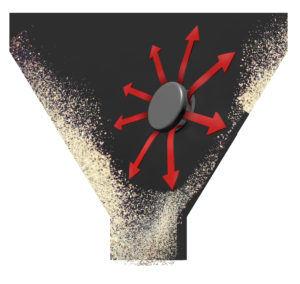
Bulk material handling equipment is designed to quickly move and process tons of material a day—and theoretically, requires minimal manual intervention.
In reality, many plant managers are plagued with material flow problems that slow down the entire process. Silos and hoppers get clogged, and workers have to stop everything they’re doing to hit them with a hammer. Material residue clings to ribbon blenders or mixers, and have to be flushed out with flour.
It’s tedious, time-consuming and can significantly affect productivity and costs. A cement company that had issues of shale hanging on the silo wall estimated that they lost $12,000 for every hour of downtime.
Even state-of-the-art equipment will run less efficiently if material isn’t flowing properly from one stage of the process to another. Here are some of the most common material handling problems, and how companies were able to solve them to get production back on track.
No flow/Poor flow
Material Flow problems can happen in practically any bulk material handling equipment, but there are three issues that are really common among silos and hoppers.
Material can form a stable arch over the outlet (bridging and arching), which can block material flow completely, or, it forms a stable open channel, but leaves stagnant material at the side (ratholing). According to Processing Magazine, “Ratholing can lead to erratic flow and reduce the bin’s live capacity by 90%.”
A material’s property can affect its tendency to form very cohesive arches, and how it responds to flow aids. Damp, moist and sticky materials will not respond to gentle aeration, and can even become more compact when vibrated or agitated.
AirSweep uses powerful air pulses which can lift even the most problematic materials.
Material segregation
Differences in particle size, density and chemistry can lead to material segregation. This becomes a problem in downstream processes, when the bulk solids need to have a uniform composition. If segregation isn’t addressed, it can affect the integrity of the formula, batch uniformity, package weights, and flowability.
Bulk powders that have poor flow properties such as fine-grained titanium dioxide—one of the commonly used nano-materials—have a tendency to segregate. A paint company used it in their new product formulation; the material would not completely empty out during the batch cycle, and it took 50 minutes to transport it a distance of 325 feet. Installing AirSweep VA-12 units effectively reduced batch time to 15 minutes.
Bulk material contamination
If equipment is not efficiently cleaned, stagnated material can contaminate any new materials that are loaded into it. This can affect the product quality—size, color, texture—and even its safety.
Material contamination can be a nightmare for food companies that have to recall products if there is any suspicion that their formula has been compromised. “The average cost of a recall to a food company is $10M in direct costs, in addition to brand damage and lost sales,” said Food&Safety Magazine, citing a joint industry study by the Food Marketing Institute and the Grocery Manufacturers Association.
A manufacturer of spices and flavorings used ribbon blenders to custom-blend ingredients. Their method of manually flushing with flour was labor-intensive and expensive, so they replaced them with AirSweep VA-12 Tri-Tri units. These not only completely cleaned the equipment, but could be conveniently removed without tools for frequent sanitizing.
Machine damage (and worker stress)
Hammering a vessel leaves dents and cracks, but even the strain of the material build up can cause structural stress.
The small cracks in the vessel can worsen over time, and even be aggravated by some kinds of material flow aids like agitators, vibrators, or air cannons. Eventually, the vessel will need to be repaired or even replaced.
Don’t discount the damage that these material flow aids can do to your workers, too. Bunge, an agribusiness and food ingredient company in the US, had issues of rice bran clumping in their hoppers and silos. “Workers had to hammer the vessels, which was ineffective and stressful for everyone in the factory. It was like fingernails on the chalkboard. You wanted to get away from it,” said John Pappenheim, Bunge’s Maintenance Manager.
AirSweep proved to be a more effective—and incredibly quiet—alternative. The air pulses lifted the rice bran back into the flow stream, and its faint hiss was further muffled by material in the vessel. Everyone in the plant could work in peace.
Material pile-up
Barnes Concrete supplies ready-mix concrete to the Connecticut, New York, and New Jersey tri-state area. The feeder loads up to 250 tons of gravel per hour. Any equipment malfunction or failure in the production line could lead to an avalanche of material.
“It would be a train wreck [to be] buried with that amount of gravel,” said plant supervisor Joe Kruzewski. He estimates that it would take three people at least three hours to shovel one ton of gravel. “We would have to shovel for days!”
Material pile-ups can happen to any plant and any industry, and can be avoided with a very small and relatively inexpensive part: a DAZIC zero speed switch. It can be attached to the rotating shaft of any equipment to detect abnormal changes in speed. So if equipment is running too fast or too slow, it sends out an alarm so you can switch off the process before a pile up occurs.
Improve material flow in material handling equipment
AirSweep releases powerful air pulses to improve material flow in bulk material handling equipment. What issues do you have with bulk material handing, and how can we help? Contact us and we’ll be happy to customize a proposal for you.





Comments are closed